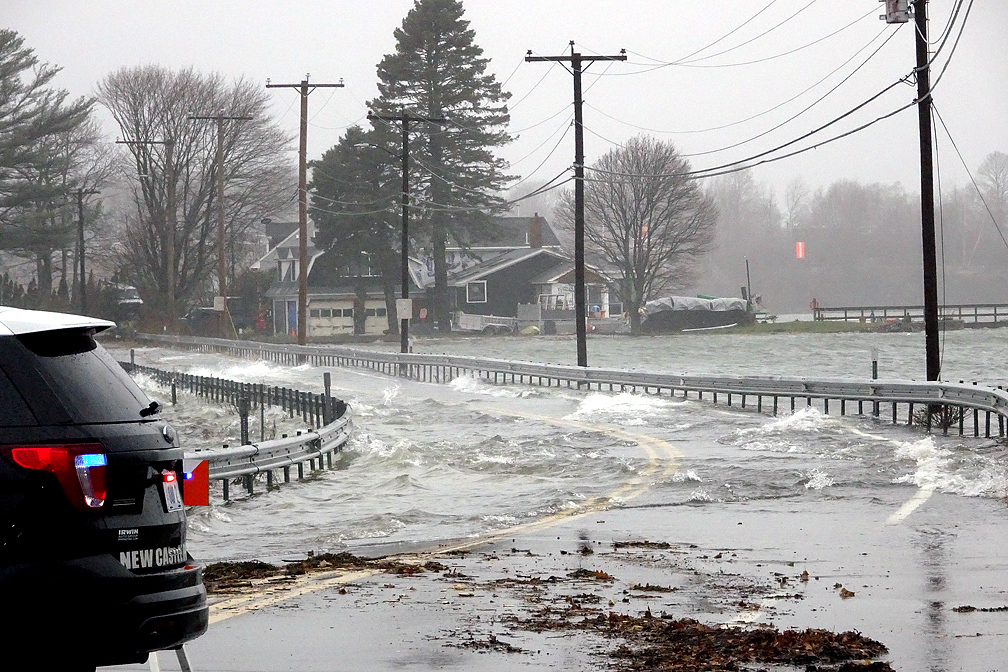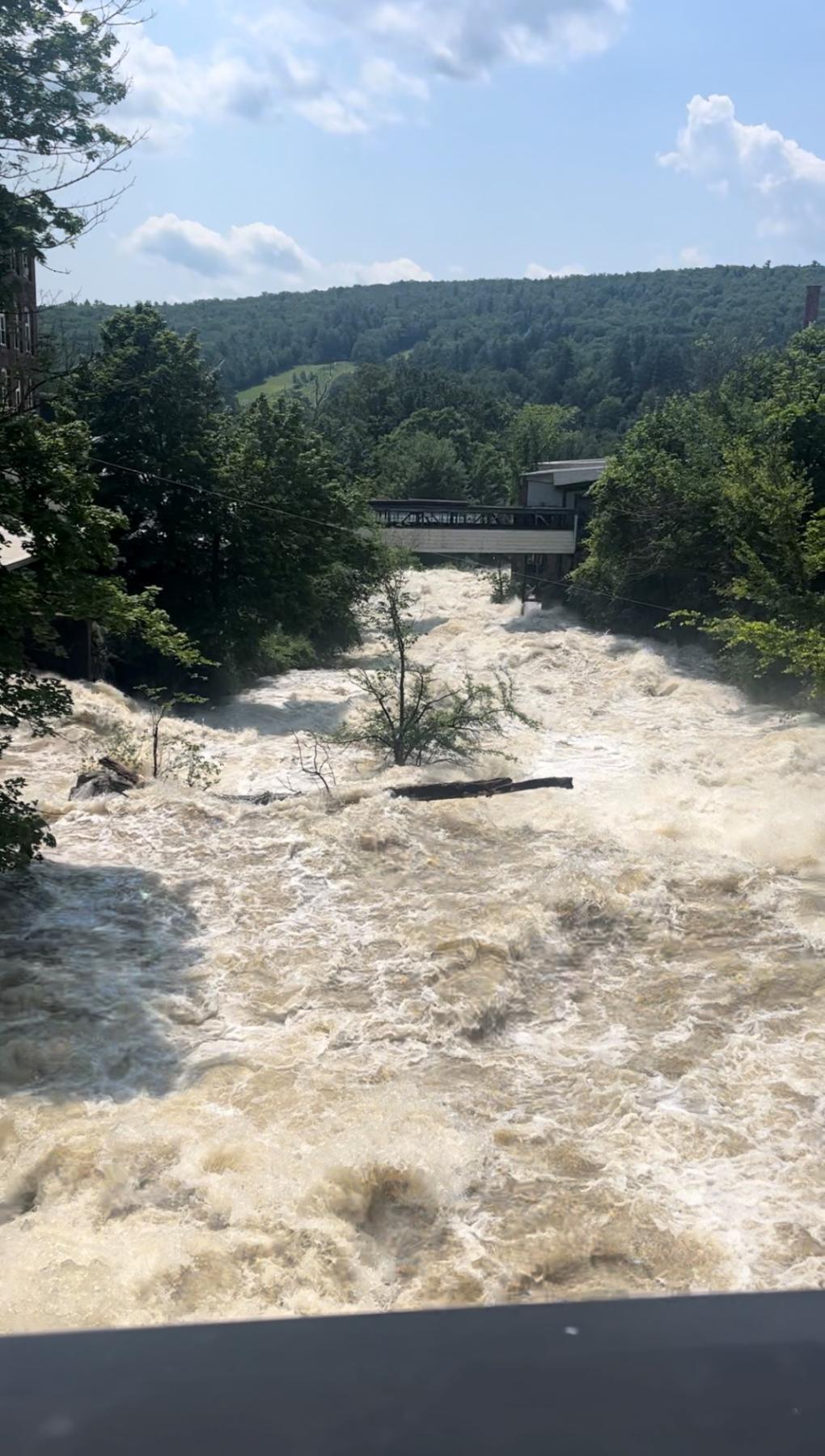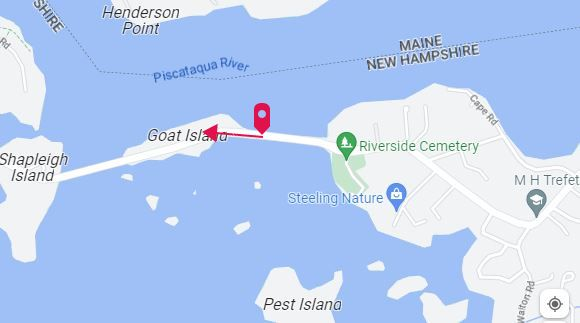The information contained in this article is not intended as legal advice and may no longer be accurate due to changes in the law. Consult NHMA's legal services or your municipal attorney.
 [Flooding on New Castle Causeway NH 1B, Courtesy the RPC, ©Jim Cerny]
[Flooding on New Castle Causeway NH 1B, Courtesy the RPC, ©Jim Cerny]
Global temperatures are rising. According to the National Oceanic and Atmospheric Administration, Earth’s average temperature has risen by about 2°F since 1880. Rates of warming are increasing, and the 10 warmest years in the historical record have all occurred since 2010. This warming allows the atmosphere to hold more water, which results in more intense rainfall and flooding events. It also results in warmer oceans releasing latent heat, which is the energy source driving hurricanes and coastal storms. In the face of these climate shifts, New Hampshire communities are facing steep costs and repetitive losses from 100-year storm events that may in fact occur multiple times per decade.
Regional planning commissions play a crucial role in facilitating collaboration and assisting communities as they tackle complex challenges associated with today’s extreme precipitation events and prepare for the climate threats of the future—with concerns ranging from inland flooding to coastal storm surges and groundwater rise. This article explores key tools and on-the-ground actions taking place today across four regional planning commissions working to foster greater resiliency in New Hampshire communities.
Managing Stormwater to Address Inland Flooding
This past July, the same heavy rainfall that overwhelmed Vermont impacted several NH communities, causing widespread road closures and destroying roads, farmland, and public infrastructure.
 [Mascoma River flooding, Courtesy UVLSRPC]
[Mascoma River flooding, Courtesy UVLSRPC]
For New Hampsire inland communities in the Upper Valley and Lake Sunapee regions, road agents and highway departments are fully aware of the threat of higher intensity storms. These municipal staff work on the front lines to manage water quantity and water quality challenges. They care for all types of public drainage networks including roadside ditches, drainage pipes, and stream crossing structures, all of which comprise the foundational elements of stormwater infrastructure.
The Upper Valley Lake Sunapee Regional Planning Commission (UVLSRPC) is collaborating with communities on two key adaptation efforts. First is the optimization of maintenance, with structures checked and cleared before any major rain event, as well as assets monitored year round to ensure good conditions are maintained. Communities are purchasing new equipment to support this maintenance, such as truck-mounted leaf blowers and culvert cleaners. The second measure addresses the upsizing of pipes and bridges to handle higher flows, which has become the standard for all replacement projects. While these efforts by municipal staff have undoubtedly reduced the severity of flooding this summer in our communities, unfortunately, damage from flooding still happens and much work still remains to be done.
Strategies involving diverse stakeholders are needed to better adapt to higher amounts of rain over shorter periods of time. For example:
- Private landowners can address stormwater management on their own site and not send additional runoff downstream. Voluntary resources are available from NHDES SOAK up the Rain program.
- Municipal land use regulations, including zoning and site plan review, can include a zero tolerance for additional volume and/or rate of stormwater going off-site.
- Municipal regulations and Planning Boards can encourage reductions in impervious surfaces, support new green infrastructure technologies, and maintain riparian buffers near water bodies.
- All stakeholders can make the conservation and restoration of floodplains, riparian zones, and other natural areas a top priority, as this represents the most resilient and cost-effective strategy for managing stormwater.
UVLSRPC is expanding its stormwater planning services to support these efforts. A series of public education events will be hosted this fall to provide homeowners with the reason and resources to adjust their property management. In addition, the Commission is working closely with many municipal staff to advance planning for stormwater in regulations and structural design. Learn more at www.uvlsrpc.org/projects/stormwater/.
Shaping Public Understanding of Sea Level Rise to Inform Local Policy
In planning for future sea level rise (SLR), The Rockingham Planning Commission (the RPC) completed the Seacoast Transportation Corridor Vulnerability Assessment (STCVA) to identify areas susceptible to future flooding due to SLR and to demonstrate how higher sea levels might impact the function of the road network and access to the Seacoast.
Recent storm events such as the December 23, 2022 storm remind us of our existing vulnerabilities to extreme weather and provide a glimpse into a warmer, wetter future with rising sea levels. The combined high tide and nearly three-foot storm surge on December 23 correlated closely to the four-foot SLR Scenario assessed in the SCTVA study.
During the December 23 storm, more than 20 roadways identified in the STCVA experienced flooding levels like the predicted flooding with a future sea level rise of between three and four feet. The RPC documented the flooding of December 23 in a Story Map entitled “The Future is Now” (https://arcg.is/19WvKj) to demonstrate how today’s storm events offer a glimpse of a warmer future with higher sea levels. Maps and images show how communities could experience twice daily high tides that might regularly overtop existing infrastructure, and where storm conditions could push flooding into higher ground.

The December 23 storm's impacts revealed the most vulnerable locations of our infrastructure and showed us which locations are most likely to be flooded by high tide on a daily basis. These insights can help decision-makers better plan and implement needed infrastructure improvements that will both mitigate the storm events of today and maintain access to the coast in the future.
Protecting communities against the impacts of today's storms and future sea level rise requires incorporating climate change into infrastructure planning and adopting more innovative and stringent floodplain management policies. Building on the STCVA as well as the NH Coastal Flood Risk Guidance, the RPC is working with communities to incorporate flood risk projections into local land use policies.
In 2023, after working with the RPC, the Town of Exeter voted to adopt “Advisory Sea Level Rise (SLR) Risk Areas” into its Zoning Ordinance to show which areas in town are projected to be impacted by four feet of sea level rise plus storm surge. The purpose of the SRL Risk Areas is to educate property owners and developers of the potential future risk to specific properties in town and encourage any construction within the SLR risk areas to adhere to stricter development standards.
Additionally, The RPC is currently working with the Town of Hampton to adopt higher floodplain management standards into its zoning ordinance, including more stringent construction and design standards for buildings in the special flood hazard area that account for today's routine flooding and future sea level rise.
The RPC is also working with the Town of Hampton in partnership with the NH Department of Environmental Services to develop a town-led process for acquiring FEMA Hazard Mitigation Grant Program funding on behalf of property owners for structure elevations and/or voluntary buyouts. The project involves designing a program that supports residents looking for options to reduce flood risk to their properties and streamlines the process of obtaining federal funding to elevate or relocate.
Applying Federal Mitigation Guidance to Local Planning
On April 19, 2023, a new Local Mitigation Planning Policy Guide, released by the Federal Emergency Management Agency (FEMA), went into effect. This updated guidance applies to all local governments that develop, update, and implement local mitigation plans. A separate State Mitigation Planning Policy Guide was released In conjunction with the local policy guide.
Strafford Regional Planning Commission (SRPC), like many of the other planning commissions in the state, provides municipalities with professional services to prepare and update local hazard mitigation plans. Last fall, upon receiving a grant through Homeland Security and Emergency Management (HSEM), SRPC began the update process with five communities, including Durham, Middleton, Milton, Nottingham, and Strafford.
The Town of Durham was the first community to utilize the new guidance. As such, SRPC overhauled the plan template to adequately address the required changes, including improvements to the planning process to incorporate a broader range of sectors, community lifelines, and community-based organizations that support underserved communities; inclusion of climate change in the risk assessment; a renewed focus on building codes and land use regulations; and the consideration of both current and future risks.
Durham was uniquely positioned to address the new climate change requirements as the Town had recently partnered with SRPC to develop a Climate Action Chapter to the Master Plan, as well as a Vulnerability and Planning Study on Sea Level Rise Impacts on Groundwater. The master plan provides a summary of the most recent climate science, identifies local impacts, and develops a comprehensive list of recommendations that address climate-related issues. Additionally, SRPC, in partnership with staff from the University of New Hampshire and New Hampshire Sea Grant, conducted an extensive outreach campaign that included stakeholder input sessions and opportunities for residents to provide input on prioritizing actions.
 [Map of Durham groundwater rise with 6 feet of sea level rise, Courtesy SRPC.]
[Map of Durham groundwater rise with 6 feet of sea level rise, Courtesy SRPC.]
The purpose of the groundwater rise project was to determine the susceptibility to groundwater rise and saltwater intrusion for public and private drinking water supplies, private septic systems, contaminated sites, stormwater infrastructure, utilities, roads, and municipal critical facilities in low-lying areas. The final report and associated Groundwater Modeling Maps improves the Town’s understanding of future groundwater rise vulnerabilities and guides decision-makers on future capital improvement projects that may be necessary to reduce risk. These resources are instrumental planning mechanisms for improving resiliency and were used extensively during the hazard mitigation update.
Leveraging Roadway Adaptation as an Entry Point for Climate Planning
The functionality and reliability of the transportation network is a priority issue for every community, and the Southern NH Planning Commission (SNHPC) has found that the topic of roadway adaptation offers a strategic entry point for bringing stakeholders together to address pressing concerns. The Commission is applying a practical lens to gather insights from fellow RPCs, promote key tools and resources, and develop a roadway adaptation toolkit that will help lay the foundation for advancing broader, multi-faceted climate goals.
In 2020, SNHPC released a Regional Vulnerability Assessment (RVA) that systematically documented the status of the region’s roadway stream crossings using available climate data. The RVA examined more than 1,600 culverts and bridges to develop a priority list of the most vulnerable stream crossings, and the analysis was integrated into an interactive GIS map that is used to inform decision-making around infrastructure improvements. Today, the SNHPC team is building upon the RVA and expanding the analysis by looking beyond bridges and culverts to understand vulnerabilities related to steep slopes and flood prone areas. The Commission is also applying a corridor-level lens to support a more integrated approach to regional transportation planning, since upgrades at one site can have downstream impacts for other roads and other communities.
In April 2023, SNHPC hosted an inaugural regional climate planning workshop that brought together more than 40 municipal officials, regional stakeholders, and state and national experts to discuss key opportunities for adapting our roadways in the face of climate change. The conversation touched upon a wide array of community priorities. As one workshop participant explained, “It’s essential to connect these strategies together to bake in resilience. We need to inventory our vulnerable assets, link that with climate data to get real-time updates, and consolidate information to inform the design standards, systems, and processes that we’re using every day.”
 [Regional Climate Workshop, Courtesy SNHPC]
[Regional Climate Workshop, Courtesy SNHPC]
SNHPC is now integrating technical findings and collaborator feedback into a roadway adaptation toolkit scheduled for release this fall. Featuring corridor-level data and a checklist of roadway adaptation strategies, the toolkit is intended to jumpstart critical conversations about adaptation needs to help identify priorities and practical implementation opportunities at the local level.
Since climate impacts don’t recognize municipal boundaries, SNHPC will continue embracing its role as a convener—supporting our local communities, sharing practical tools, and collaborating with fellow RPCs and state leaders to take coordinated action in the face of climate change.
These stories capture important examples of the climate-related challenges New Hampshire is facing today. Yet communities are facing many other concerns, ranging from heat waves and drought, to ecological shifts impacting agriculture and tourism economies.
Historic data is no longer a reliable predictor of future risk, and it is essential to recalibrate policies and systems at federal, state, and local levels to align with updated climate forecasts. By collaborating across sectors, regional planning commissions can help coordinate proactive solutions that address the unique priorities in our communities – whether updating flood models, revising land use plans, redesigning roadways, or pursuing green infrastructure innovations to manage stormwater. The time to act is now, and regional planning commissions are here to help.
Interested in learning more about what is happening in your region to address climate challenges? Visit the NH Association of Regional Planning Commissions to connect with the regional planning commission in your area.
Editor's Note: In the July/August 2023 issue, we listed Victoria Davis, Senior Planner with the Upper Valley Lake Sunapee Regional Planning Commission (UVLSRPC) as the author of the article, Household Hazardous Waste Management, found on page 32. We would like to recognize two other authors, David Jeffers, Regional Planner, and Matt Rose, Solid Waste Planner, from the Lake Regional Planning Commission, for their contributions to this article.